In the United States, the catalpa tree (pronounced “catawba”) has a long history of cultivation and use that dates back hundreds of years to the Native American people who lived on the North American continent prior to European colonization.
However, these are actually two distinct species that are both called “catalpa trees.” These are Catalpa speciosa (northern catalpa) and Catalpa bignonioides (southern catalpa). Though the two species do have a lot in common, they also have some significant differences that allow you to identify each species.
This article compares northern catalpa and southern catalpa, comparing and contrasting their similarities and differences in size, flowers, and foliage.
Before we get started, here are several characteristics that northern catalpa and southern catalpa have in common:
- Both are resilient trees that can grow in a variety of soil conditions and environments
- Both are native to the southern half of the United States
- Both have been widely planted beside roadways and in cities
- Both produce beautiful, showy white flowers
- Both produce fruit in the shape of seed pods, which look like green beans that turn brown in the fall
However, there are also several ways in which northern catalpa and southern catalpa are different, beginning with their geography, size, and growing patterns. Let’s learn more about both of these species together, beginning with their history, where they grow, and how you can identify them. Let’s dive in!
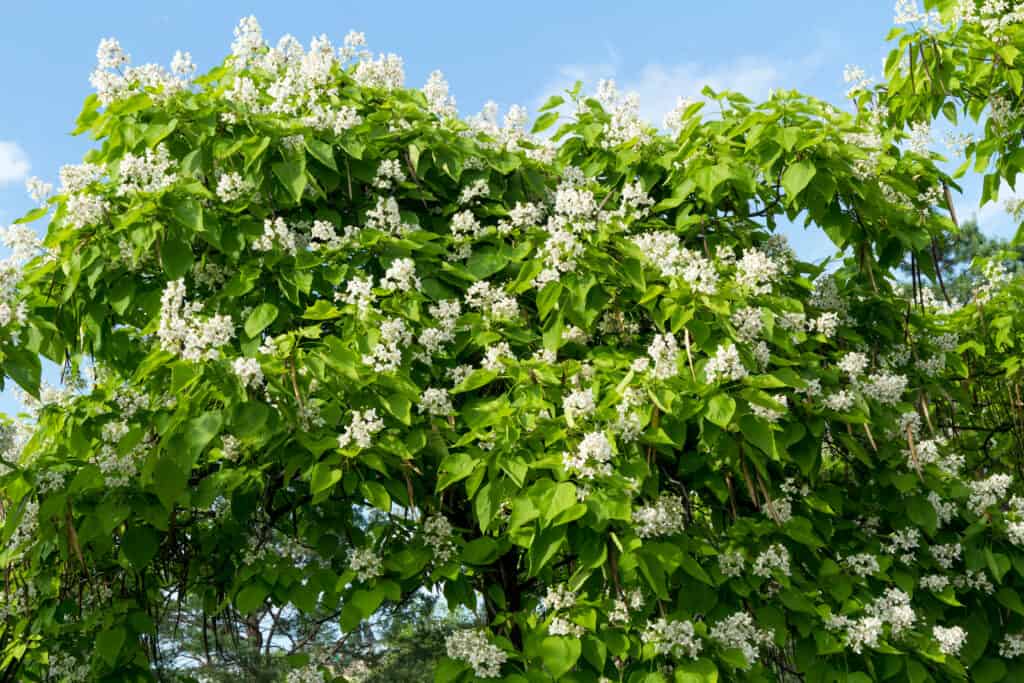
Both northern catalpa (
Catalpa speciosa) and southern catalpa (
Catalpa bignonioides) produce beautiful, showy white flowers.
©catus/Shutterstock.com
Comparing Northern Catalpa and Southern Catalpa
| Characteristic | Northern Catalpa | Southern Catalpa |
|---|---|---|
| Scientific Name | Catalpa speciosa | Catalpa bignonioides |
| Family | Bignoniaceae | Bignoniaceae |
| Common Name | Northern catalpa | Catalpa tree, bean tree, cigar tree, southern catalpa |
| Origin | North America, primarily in the southern and midwestern states of Arkansas, Missouri, Tennessee, and southern parts of Illinois and Indiana | North America, primarily in the southern states of Alabama, Georgia, Florida, Louisiana, and Missouri |
| Description of Plant | Northern catalpa is a medium-to-large-sized deciduous tree. It blossoms with large white flowers that grow to be approximately 2 inches long. It also bears fruit that are bean-like seed pods that are brown in the fall and can reach up to 22 inches long. Leaves are light green and grow to be 6 to 12 inches long and 4 to 8 inches wide. They are pointed at the tips and turn a yellowish color in the fall. When the leaves are crushed, they do not have any significant smell. | Southern catalpa is a medium-sized deciduous tree. It blossoms with white flowers and bears fruit, which are bean-like seed pods that turn brown in the fall and can grow to be up to 15 inches long. The flowers bloom early to late in the summer and are white, but sometimes take on a more purple color. Each flower grows to be about 1.5 inches across. The leaves are green, heart-shaped, and large, about 10 inches long and 6 inches wide. When the leaves are crushed, they emit an unpleasant odor. |
| USDA Hardiness Zone(s) | 4-8 | 5-9 |
Descriptions of Northern Catalpa and Southern Catalpa
The plant called northern catalpa is the species Catalpa speciosa. While the name may lead you to believe that the northern catalpa tree is a native plant to the northern half of the United States, this is actually incorrect. Northern catalpa grows in the southeast and midwestern regions of the United States. You can find northern catalpa trees in states often considered “southern,” such as Arkansas, Missouri, Tennessee, and southern Indiana and Illinois. Northern catalpas are medium-to-large deciduous trees that blossom with beautiful white flowers that have yellow stamens and purple on the inside of the flower. Northern catalpa trees have large leaves that grow in an oval shape and can be up to 12 inches long. The trees also flower in the middle of the summer, bearing long seed pods.
The plant known most commonly as southern catalpa, Catalpa bignonioides has also been called catawba tree or Indian bean tree. The southern catalpa tree is also a native plant to the southern region of the United States but grows deeper south than its northern catalpa counterpart. You will often find southern catalpa trees growing in states such as Alabama, Georgia, Louisiana, and Florida, as well as east Texas and parts of Missouri. Southern catalpa trees are smaller than northern catalpas, and are medium-sized, deciduous trees. They also bear beautiful white flowers, but these are smaller in comparison with those of the northern catalpa tree. The seed pods come later in the season as well, typically in the autumn around the month of October, rather than in the summer.
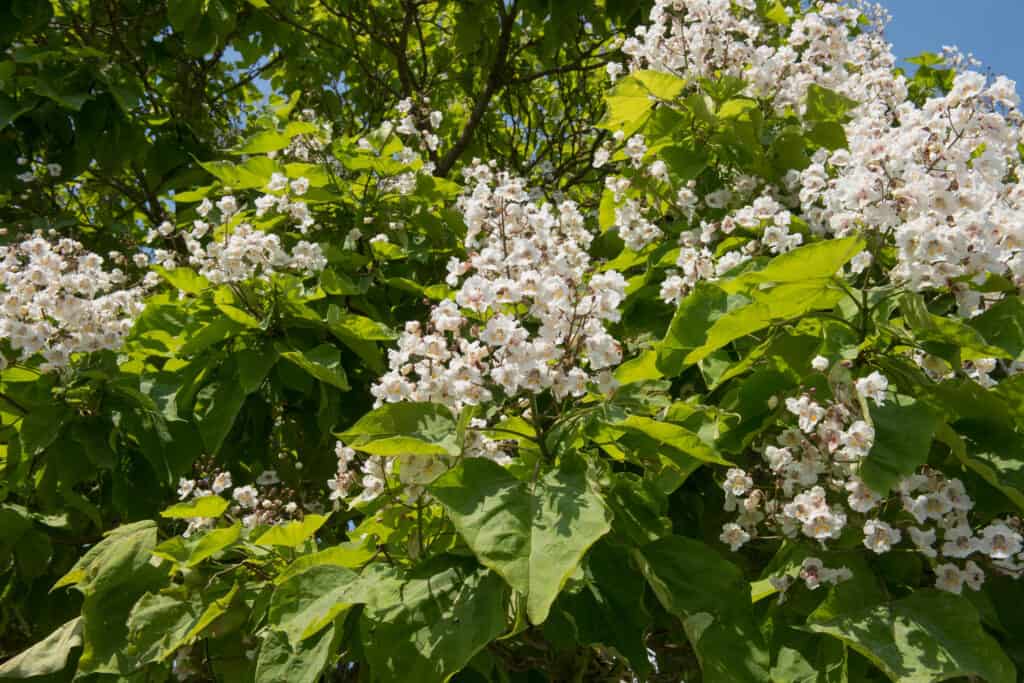
Southern catalpa (Catalpa bignonioides) flowers are smaller than those of the northern catalpa tree.
©Peter Turner Photography/Shutterstock.com
Northern vs. Southern Catalpa: History
Historically, catalpa was used by Native Americans living in the region that is now the southern part of the United States. They used the bark and leaves to make poultices and laxative-like beverages. In fact, the name “catalpa” comes from a word used by Native American people who lived in the Carolinas. When translated, the word means “head-wing,” and refers to the seed pods of the catalpa tree.
Northern catalpa was first cultivated to help build human settlements in the 1700s. At that time, the trees were cultivated for their rapid growth rate. This allowed their wood to easily and quickly be harvested to be used to build infrastructure such as fence posts and railroad ties. The northern catalpa tree’s wood is also resistant to rot, making it a quality building material that is long-lasting.
In history, the seed pods and seeds were also converted into medicines, while the tree leaves and roots were made into juice. The tree bark could be dried, ground, and brewed. These products were used to treat a number of symptoms, including asthma and breathing conditions, heart problems, and more. At times, southern catalpa was known to be used as an antidote to snake bites when brewed as a tea.
Starting in the 1900s, catalpa trees became more common throughout the United States, where they became a popular choice to line streets. They are also considered good windbreaks. Even today, catalpa tree wood is used in construction, for cabinetwork, and as an interior wood in home building.
Northern vs. Southern Catalpa: Appearance
Appearance of Northern Catalpa
The northern catalpa tree is a medium to large-sized deciduous tree. When a northern catalpa tree is fully grown, it can reach between 40 and 60 feet tall with a spread of 20 to 40 feet across. While it is still growing, the tree can gain more than a foot of height each year! Northern catalpas grow straight trunks.
You can expect that your young northern catalpa tree will produce its first flowers about seven years after being planted. When it does, these blooms will be beautiful! Northern catalpa trees bloom with clusters of trumpet-shaped white flowers that grow to be about 2.5 inches long and more than an inch wide. They are large and can be somewhat fragrant and will be well-dispersed across the tree.
The tree’s leaves are large and grow in a heart-like shape, reaching up to 12 inches long and 4 to 8 inches wide. They are green in the spring and summer and turn a slightly yellow color in autumn. Northern catalpa trees are also distinctive for bearing seed pods that look like beans. These large green seed pods can reach 20 inches long! They turn green as they mature over the course of the season. When split open, they contain many inch-long seeds. The shape of these seed pods is where the catalpa tree gained its nickname as a “cigar tree.” Look at the cigar-like shape of the long, brown pods!
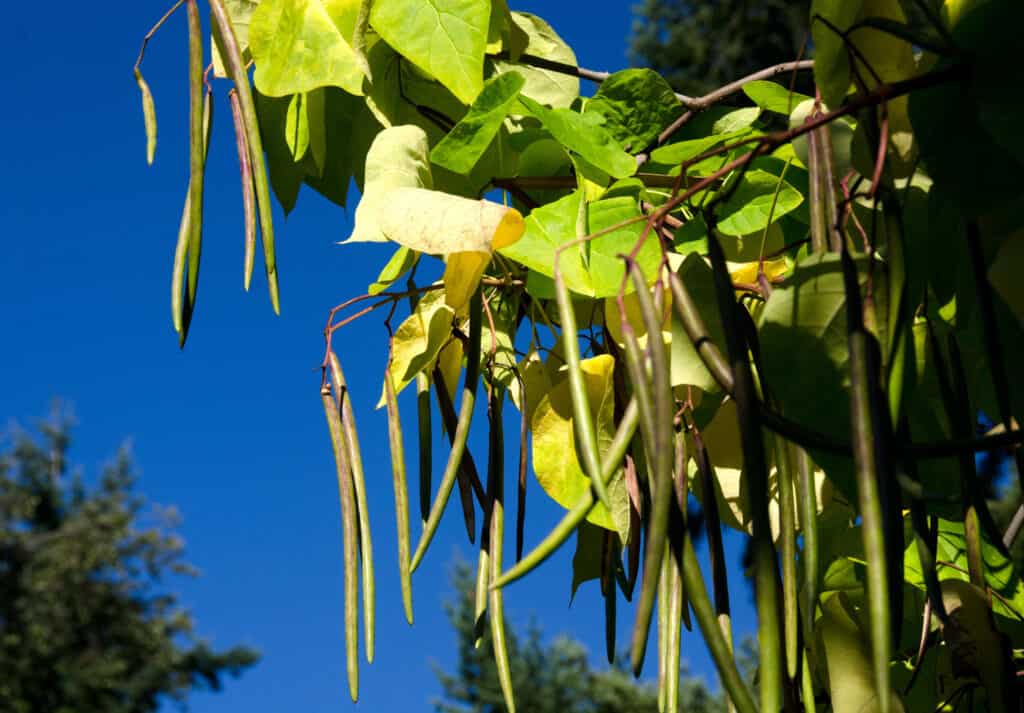
Northern catalpa (Catalpa speciosa) seed pods can reach 20 inches in length resembling beans.
©iStock.com/dmitriko
Appearance of Southern Catalpa
While southern catalpas have much in common with northern catalpas, they do differ in several significant ways. Southern catalpa trees are medium-sized, and so don’t grow as tall as northern catalpas. They typically only reach 25 to 40 feet in height, though they have an equal width. The branches often tend to grow in a more crooked, twisted, or irregular formation. Like the northern catalpa, southern catalpa trees have heart-shaped leaves, which tend to be about the same size: 6 to 12 inches long and 4 to 6 inches wide. The white flowers grow in clusters of 10 or 20, with each flower reaching about 1.5 inches across. This makes them slightly smaller than the flowers of the northern catalpa.
The seed pods of the southern catalpa are also slightly smaller than those of the northern catalpa. After the tree flowers, the seeds grow in long, skinny pods that can reach up to 15 inches long. In the fall season, the pods mature from green to dark brown. They also split open to release the many seeds. These seeds ripen in the autumn months into early winter.
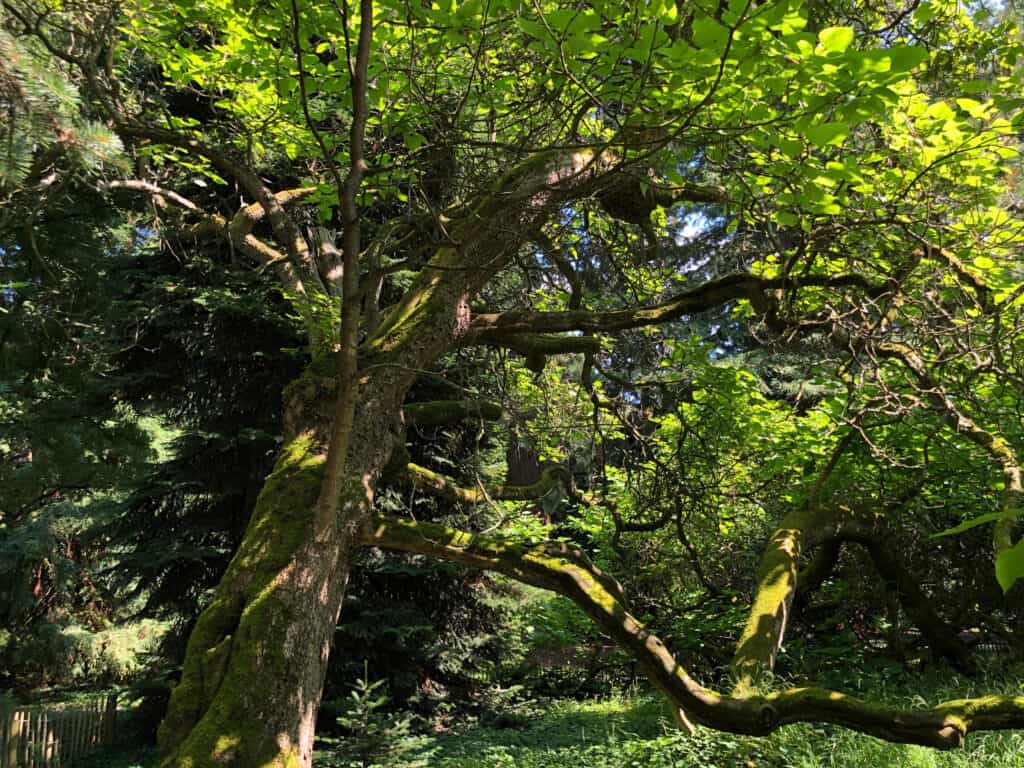
Southern catalpa trees don’t grow as tall as northern catalpas and have branches that grow in a more crooked, twisted, or irregular formation.
©Mario Krpan/Shutterstock.com
Northern vs. Southern Catalpa: Growing Conditions
Northern catalpas grow well in a variety of soils and a wide range of soil conditions. The plant can tolerate acidic, alkaline, loamy, rich, sandy, silty, well-drained, wet, and clay soil. However, the tree does grow best when it has at least four hours of direct sunlight each day. You will most often find northern catalpa trees in USDA Hardiness Zones 4-8, although you may occasionally find some outside of this region.
Southern catalpas can also withstand a variety of soils and soil conditions. Like its northern counterpart, the southern catalpa can tolerate clay soil, wet or dry conditions, and a range of other climates and environmental factors. However, it thrives best in rich, moist soil. Also like the northern catalpa trees, southern catalpas grow best when they have several hours of direct sunlight each day – so they will not thrive in full shade. Southern catalpas are native to the southern part of the United States and grow best in USDA Hardiness Zones 5-9. This makes the tree more suitable and prevalent in hotter parts of the United States, such as the climates found in its home origins in states such as Florida, Georgia, and Alabama.
Both species of catalpa trees can be grown from seed or from root cuttings.
Northern vs. Southern Catalpa: Cultivation Tips
If you would like to grow your own catalpa tree, here are some tips. First, consider your USDA Hardiness Zone and the climate of where you live. If you live in the Midwest or a state such as Tennessee, North or South Carolina, or Arkansas, a northern catalpa tree may grow best in your area. If you live in the deep south, in a state such as Georgia, Florida, or Alabama, you may prefer to grow a southern catalpa tree.
Next, choose a sunny location where your plant will receive adequate sunlight. The ideal soil will be moist, though both species of catalpa plants will tolerate a wide range of soil conditions. Once you place your young tree in the ground, you will want to water it regularly, at least once a week. After that, your plant will be resilient in the face of regular rain and watering or when experiencing drought. Though catalpa trees are low-maintenance, you may want to prune your young tree in the first two years after planting. From then on, you can prune sporadically to ensure that no branches impede new growth.
Watch out for pests such as Japanese beetles, aphids, mealybugs, and of course, the catalpa hornworm. Though some people who like to fish may appreciate having catalpa hornworms (caterpillars) to use as fishing bait, watch out for these pests! They have the ability to completely defoliate your catalpa tree and will come in two generations: one in the spring and one in the late summer.
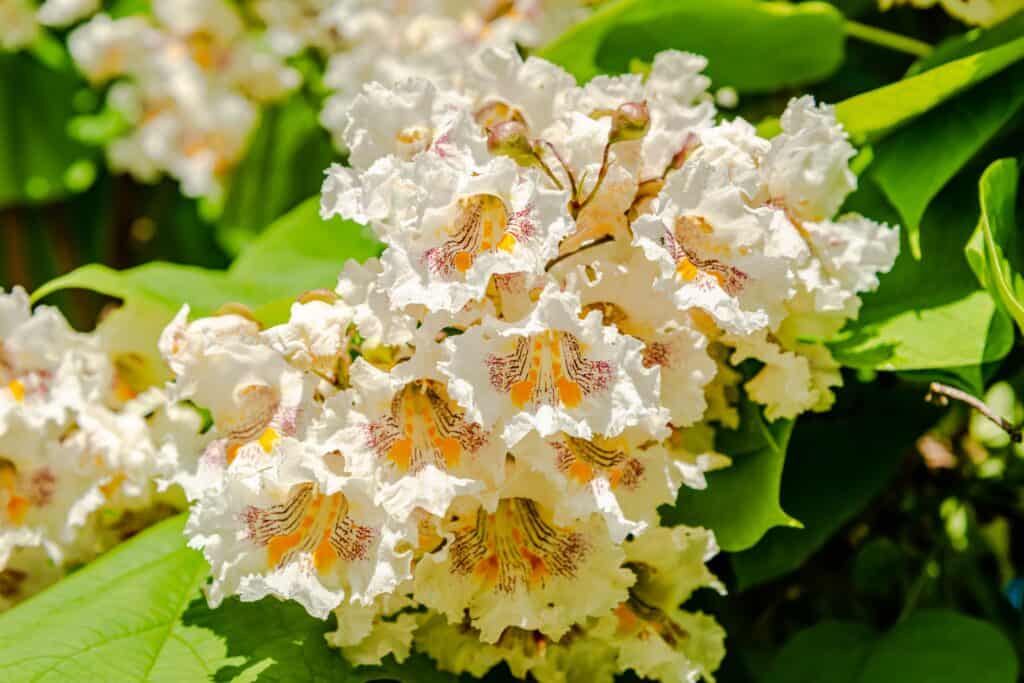
Northern catalpa trees bloom with clusters of trumpet-shaped white flowers that grow to be about 2.5 inches long.
©Pitofotos/Shutterstock.com
Northern vs. Southern Catalpa: Seed Pods
One way that you can readily identify whether a tree is a northern catalpa or a southern catalpa is by crushing the leaves. When the leaves of a northern catalpa tree are crushed, they do not generate any significant smell. However, when the leaves of the southern catalpa tree are crushed, they emit an unpleasant odor that some describe as “rank” or “rotten.”
Northern vs. Southern Catalpa: Uses
Today, both northern and southern catalpa trees are primarily grown to be large ornamental shade trees. You will often find them planted in city areas in lawns or on the side of roads.
Northern catalpa trees are sometimes planted to attract green catalpa worms. These are caterpillars that are often used in fishing and are prized as being good bait. These catalpa worms depend on the two species of catalpa trees as their sole source of food. As these caterpillars feed on the tree foliage, they grow and eventually develop into the catalpa sphinx moth. Though these caterpillars can do significant damage to a tree’s foliage, a healthy tree will recover during the following growing season. Catalpa trees are native to the southern part of the United States, and the catalpa worms are too. This allows the two to live in coexistence, as the worms have many natural predators. These predators help to keep the catalpa worm population in check.
Because southern catalpa trees have extensive root systems, they can serve effectively as resilient windbreaks. They can also help to stabilize the soil, particularly because they often grow near areas of erosion or flooding.

Catalpa worms (caterpillars) feed on the foliage of catalpa trees, eventually growing into the catalpa sphinx moth.
©Katja Schulz from Washington, D. C., USA, CC BY 2.0 <https://creativecommons.org/licenses/by/2.0>, via Wikimedia Commons – License
How Many Species of Catalpa Trees Are There?
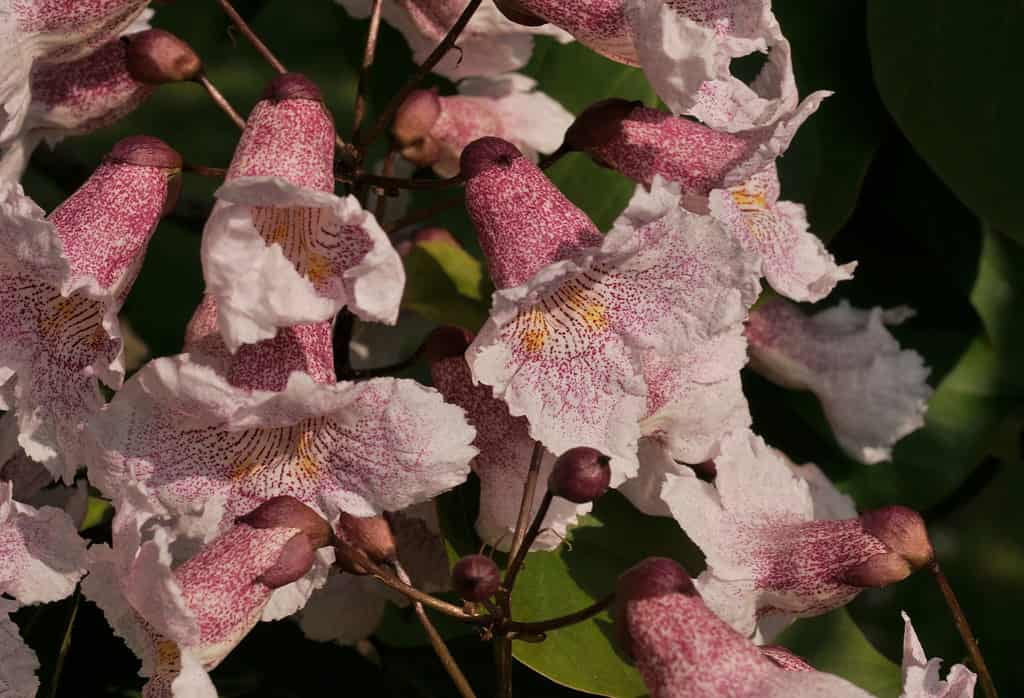
The Manchurian catalpa if noted for its gorgeous pink blossoms.
©HorsePunchKid / CC BY-SA 3.0 – License
There are more species of catalpa than just the northern and southern varieties. Catalpa trees can also be found in parts of East Asia and the Caribbean. The complete list of catalpa species is as follows:
- Southern Catalpa (Catalpa bignonioides) North America, primarily in the southern states of Alabama, Georgia, Florida, Louisiana, and Missouri
- Manchurian Catalpa (Catalpa bungei) Cultivated in China as an ornamental tree and for its wood
- Chinese Bean Tree (Catalpa fargesii) Native to China, growing pink blossoms in the spring
- Chinese Catalpa (Catalpa ovata) Native to China with white blooms tinged with yellow
- Northern Catalpa (Catalpa speciosa) North America, primarily in states of Arkansas, Missouri, Tennessee, and southern parts of Illinois and Indiana
- Catalpa brevipes Found in Cuba, Dominican Republic, and Haiti in dry, limestone soil forests
- Catalpa purpurea Caribbean variety
- Catalpa macrocarpa Caribbean variety
- Catalpa longissima Caribbean variety
In Summary
This article compares northern catalpa trees and southern catalpa trees, two related but distinct species of flowering plants that grow in the southern part of the United States. Both produce showy white flowers, have large leaves, and yield fruit that looks like bean-shaped seed pods. However, they are also distinct in some significant ways. To identify them, you can use your knowledge of their growing environment and geography. You can also reflect on the different sizes and appearance of their flowers, leaves, and fruit. When in doubt, crush the leaves of the tree! If it has a distinct, unpleasant odor, you have a clue: it might be a southern catalpa.
Hopefully, after reading this article, you are better prepared to appreciate any catalpa tree you come across in nature – whether it’s a northern catalpa or a southern catalpa!
The photo featured at the top of this post is © iStock.com/igorbondarenko
Sources
- Arbor Day, Available here: https://www.arborday.org/trees/treeguide/TreeDetail.cfm?ItemID=805#:~:text=History%2FLore,the%20tree's%20fast%20growth%20rate.
- Yale, Available here: https://naturewalk.yale.edu/trees/bignoniaceae/catalpa-bignonioides/catalpa-74#:~:text=Modern%20industrial%20uses%20of%20Catalpa,in%20windbreaks%20for%20conservation%20purposes.
- Etymology Online, Available here: https://www.etymonline.com/word/catalpa
- UT Austin, Available here: https://www.wildflower.org/plants/result.php?id_plant=cabi8
- North Carolina Extension, Available here: https://plants.ces.ncsu.edu/plants/catalpa-bignonioides/
- North Carolina Extension, Available here: https://plants.ces.ncsu.edu/plants/catalpa-speciosa/
- USDA, Available here: https://plants.usda.gov/DocumentLibrary/plantguide/pdf/pg_casp8.pdf
Thank you for reading! Have some feedback for us? Contact the AZ Animals editorial team.






